
Autism Outreach Service
Top Tips for Holidays
For more information,
please contact the
Autism Support Team
on 0116 305 9400
or email sts@leics.gov.uk
X Planning and preparation for the holidays
X Visuals and structure

Days Out
National key scheme
You might like to join the National Key Scheme. This enables you to use
accessible toilets. The National Key Scheme can only be used by people
with a Radar key. In order to obtain a Radar key you can contact:
Radar - the disability network Tel: 020 5250 3222
Web: www.radar.org.uk/radarwebsiteltabis/41/default.aspx
Planning ahead by taking legal forms
When visiting tourist attractions you might want to take a copy of your child ‘s diagnosis
and their Disability Living Allowance (DLA) or Carer’s Allowance (CA). Often this can give
you discounts, priority queuing and wristbands that allow preferential treatment.
Autism alert card
The Autism Alert Card - designed by the National Autistic Society
(NAS), this card is designed to tell people about the condition, and
asks them to show respect and tolerance. The card comprises a
wallet which contains a leaflet of key facts about autism,. and a
credit-card style insert where people can write emergency contact
details. It is available from the National Autistic Society.
Author: The National Autistic Society Code: NAS 565
Recommended days out
The National Autistic Society (NAS) recommends a variety of days out that are autism-
friendly, for a full list please go to their website, however these are a few that you might like:
Alton Towers - allows concessions and priority queuing
Bournstream - an adventure playground for children with special needs or disabilities It is
completely enclosed and is situated near Wotton-under-Edge in the Cotswolds.
Thorpe Park - again concessions and priority queues.
Cinema visits
For visits to the cinema, you might like to join the cinema exhibitors association. This allows
a carer a free place on cinema visits.
The Card Network Network House, St. Ives Way, Sandycroft, CH5 2QS
Tel: 0845 123 1292 Fax: 0845 123 1296
Instructions
Fold and stick both sides together
Cut out and fold your card
Fill in the spaces
Carry it in your purse or wallet
1
2
3
4
Autism
Alert Card
Emergency contact
details
Name: .........................................................................
Number: .....................................................................
Email: ..........................................................................
Please contact this person
Please see inside for important
information.
I am
autistic
Thank you for ordering your Autism Alert Card.
Many members of the public don’t understand autism and how things they take for granted
might cause difficulties for people on the spectrum. This card is a great way for you to let them
know you are autistic and that you may need some extra time or help in certain situations.
Hello,
My name is: ..............................................
........................................................................
........................................................................
........................................................................
........................................................................
Thank you
Autistic people sometimes:
• struggle with change, new situations and talking
to new people
• get very anxious in social situations
• feel overwhelmed by lights, noise and too much information
• need extra time to process information, like questions
or instructions
• have meltdowns or go into shut down if it is all too much
To find out more, go to autism.org.uk
Please fill in to explain to people
why you are showing them this card.
For example: Sometimes I get anxious and stressed by...............
......................................
You can help me by giving me some time
or contacting the emergency person on the back of this card.
One in 100 people are autistic. You are not alone.
The National Autistic Society is the UK’s leading charity for autistic people. Founded
in 1962 we are here to transform lives, change attitudes and help create a society that
works for autistic people.
www.autism.org.uk
Fold here
Cut here
Cut here
Instructions
Fold and stick both sides together
Cut out and fold your card
Fill in the spaces
Carry it in your purse or wallet
1
2
3
4
Autism
Alert Card
Emergency contact
details
Name: .........................................................................
Number: .....................................................................
Email: ..........................................................................
Please contact this person
Please see inside for important
information.
I am
autistic
Thank you for ordering your Autism Alert Card.
Many members of the public don’t understand autism and how things they take for granted
might cause difficulties for people on the spectrum. This card is a great way for you to let them
know you are autistic and that you may need some extra time or help in certain situations.
Hello,
My name is: ..............................................
........................................................................
........................................................................
........................................................................
........................................................................
Thank you
Autistic people sometimes:
• struggle with change, new situations and talking
to new people
• get very anxious in social situations
• feel overwhelmed by lights, noise and too much information
• need extra time to process information, like questions
or instructions
• have meltdowns or go into shut down if it is all too much
To find out more, go to autism.org.uk
Please fill in to explain to people
why you are showing them this card.
For example: Sometimes I get anxious and stressed by...............
......................................
You can help me by giving me some time
or contacting the emergency person on the back of this card.
One in 100 people are autistic. You are not alone.
The National Autistic Society is the UK’s leading charity for autistic people. Founded
in 1962 we are here to transform lives, change attitudes and help create a society that
works for autistic people.
www.autism.org.uk
Fold here
Cut here
Cut here

Holidays
Consider if you are not going ‘away on holiday’ saying that you are
having ‘time away from school’. Often a very literal understanding of
‘holiday’ may mean that your child expects to be going on a ‘holiday’.
Deciding where to go?
X Consider your child ‘s likes and dislikes, but also try to think what you, as a family, will like.
Often a ‘best fit’, something that suits a little of everyone’s tastes is best.
X Try to find out the facilities available, the National Autistic Society provides lists of
recommended places that can be inclusive of people with disabilities and friendly
towards those with autism.
X Don’t be afraid to ask your chosen destination for specific things, for instance ground
floor rooms if you are worried about the height of a hotel room; closeness of your room
to facilities that might be noisy and disturb your child ‘s sleep, and so on.
X You might be going to visit relatives - can you give them an update of what your child
may need or importantly what they would not like? Family can be supportive but they
may also need just as much support if they have not been in regular daily contact, to
adjust to any changes your child may have made.
X If relatives are visiting you -could they stagger their visits?
Planning your journey
X Every parent plans, parents of children with autism may need to plan more!
X You could make a simple itinerary of what will happen when you are travelling to and
from your holiday destination.
Air travel
If you are travelling on a plane you can telephone the airline beforehand. Often they are
more than pleased that you have provided them with information about your child ‘s
needs and they are then happy to ma~e some alternative arrangements for you to make
your journey that much easier.

What the airline might like so that they can help you make your
journey easier:
X 1) During airport security, let the security guards know that your child has special-needs
or additional medical devices.
X 2) Explain to security that your child might become upset during the screening process
and how they might react. Oer suggestions how they can handle the process sensitively
to make it easier for them and for you.
X 3) Ask them for help, they can help to load your items on to the x-ray belt whilst you
take care of your child or they can make an exception and allow you to walk through the
metal detector with your child.
X 4) You can request a private screening if you feel your child may react badly and you do
not want to draw unnecessary attention.
What If your child has other disabilities or medical conditions, what
Information would the airline need?
X 1 ) Provide them with advance notice
X 2) The carry-on rules do not apply to particular medical items - check beforehand.
X 3) Pack medications in transparent packaging but make sure that you are confident it
can pass through the x-ray scanner.
X 4) Take any medical documentation with you.
X 5) Make sure all medicines are labelled.
These are tips that parents have oered to help travel smoother:
X Take a copy of the diagnosis with you when you travel. Your UK disabled parking badge
is valid in all EU countries if you are hiring a car.
X Travel o-peak is good as it is often quieter.
X Computerised check-ins can speed up how long you need to wait.
X If you are not able to use a computerised system you can talk to your travel agent/airline
and ask them for an ‘accelerated check-in and security check’ this is where you will need
your diagnosis as evidence.
X Even if your child is older you can still go forward when there is a call for ‘passengers and
young children’.
X Don’t forget to take your child ‘s motivators - check if they are acceptable on the flight
and fit in with airport security (for instance toys with liquid inside such as water-snakes
would not be permitted)
X If your child reacts to sound you might want to get them used to wearing headphones
so that they could listen to ipqds or other devices.
This could reduce sound and oer a distraction. Earplugs might also be useful. The NAS
U0159

recommend www.flightstore.eo.uk/SEPT-Head as a suitable place to purchase child-sized ear
defenders.
X You can use www.ifly.com then find the section on “services and amenities” this will then help you to
find information about “People with special needs/Persons with disabilities”
Manchester airport have an onllne brochure you can download “Airport Awareness”
Travel advice for parents and carers of children on the Autistic Spectrum
http://www.manchesterairport.eo.uk/manweb.nsf/alldocs
How can you prepare your child for their holiday?
X If your child is used to using social stories, you could make a simple social story to introduce and
prepare them for this change.
X You could mark the days to the holiday using a visual system - mark the days at home in one colour
and the days away on holiday in another colour.
X Photographs, booklets, holiday brochures and the internet are all good sources of visual information
that you can use to either print out and prepare or personalise your social stories. Remember if
your child takes everything very literally and you cannot find the exact picture you might want, use
symbols or clipart to represent parts of your holiday so that your child is not disappointed or upset if
they get there and it is not exactly as they thought it would be.
X The use of visual support can also help in a variety of ways, you could:
1. Use visuals to help you make a daily timetable - try to keep it simple so that it allows you
flexibility but also provides enough information so that your child feels comfortable that they
have a pattern to their day.
2. Make a simple choice board of activities they could do each day.
3. Use a ‘first/then’ visual so that they can be encouraged to try a new activity followed by
something they already find rewarding, for instance, ‘first beach, then TV’.
X You could prepare for a big holiday by taking your child on smaller days out. This might help you to:
1. Find things out that may be an issue on a longer journey.
2. Get together an essential travel kit for your child.
3. Encourage your child to take part in activities that will be available to them on a longer holiday,
for instance a day out at the beach, going to the swimming pool or practicing eating out.
X Try to find a calm or quiet area when you are on holiday that your child knows they can retreat to
and will feel secure if they are feeling overwhelmed.
Try to remember to have an ‘alternative’ strategy so that you can plan for things if they do not
go quite according to plan - a ‘never mind, nobodies fault’ situation!

Going back to school
What can I do to help prepare my child for going back to
school at the end of the holidays?
X A few weeks before going back to school, you might like to start a simple countdown, this could be
a calendar you can mark o the days of the week; a visual timetable with the things you will be
doing on the days leading up to going back, or simply, a picture of school with the date on it.
X Try to involve your child in ‘going back to school routines’ if you feel they are able to cope, for
instance, a special shopping trip to buy new shoes or their new school uniform. If your child does not
like new things you might like to get everything at the beginning of the holidays so that they can
get used to seeing it hung up and can experience trying it on and feeling the texture.
X Practice with new clothing and equipment - especially if your child likes to be independent - can
they zip and unzip their new coat; fasten their new shoes or even open and close their lunchbox?
X If your child has responded well to social stories you can do a simple social story about going back
to school.
X Often schools and your Autism Outreach teacher will have worked to provide you with a school
booklet. This is something that you can read through to prepare your child for their new school or
their new class.
X If your child has been staying up late during the summer, try to readjust their sleeping patterns a
few weeks before and reintroduce a sleep schedule. This could also be true of other family routines,
often sitting down for meals might have changed or getting up early. It is important to plan ahead
and make this change gradually in the last few weeks of the holidays. Make getting up earlier fun
by planning a favourite activity or giving your child something special they like for breakfast.
X You might want to do a ‘trial run’ so that your child can experience or re-experience the school
run. It may be an opportunity for you to take things slower, you could also take photographs of the
journey so that you have something to talk about later or use in a visual schedule.
X Make a simple checklist, this could be words and pictures - it can be an aid for you and also
something you can encourage your child to be involved with.
X If you already know some of the children who will be in your child ‘s class, could you arrange a play-
date to get them back into the swing of playing and being around others?
X You could begin to make your own book throughout the summer of all the things you have done.
Encourage your child to think about taking it to school to share with their teachers and friends. Put
mementos of your activities in the book, photographs, collage and so on. This will help them make
sense of and keep track of time. It may also help recalling events when asked back at school.
X You could also make a book about going back to school -they could help to draw their class, their
teacher, friends and themselves.
Try to remember to have fun with your child. Sometimes just enjoying each other’s company is
enough and you should not need to feel you have to constantly be ‘entertaining’ just because it is the
holidays.

Cinema exhibitors
association card
Terms & Conditions
General Terms and Conditions applicable to this website and the CEA Card Scheme.
1. The CEA Card is issued by The Card Network Ltd on behalf of the UK Cinema Association (UKCA)
and remains the property of the UKCA. It is for individual cinemas to decide whether they
participate in this scheme. Any cinema has the right not to honour the CEA Card, or to retain it
where they believe it is being misused or used outside these terms and conditions.
2. When you apply for a CEA Card, you are deemed to have fully accepted the terms and conditions
set out in this document.
3. Eligibility to apply for the Card is set out below.
The person applying for a Card should be in receipt of:
X Disability Living Allowance (DLA);
X Attendance Allowance (AA);
X Personal Independence Payment (PIP);
X Armed Forces Independence Payment.
Or be registered as:
X Severely Sight Impaired (formerly Registered Blind) or Sight Impaired (formerly Partially Sighted).
So, for example, Blue Badge schemes or the Employment and Support Allowance scheme will not be
accepted as proof of eligibility. Limitations placed on Cinemas by their local licences require children
and young people under 8 years of age to be accompanied by a responsible person; consequently
an application for a Card can only be considered for a person who is 8 years of age or older.
If you are unable to find this correspondence, or do not meet the above criteria but believe that as
a result of your disability you still need someone to accompany you to the cinema, please contact us.
4. You must be 16 or over to apply for your own CEA card. If an applicant is aged between 8 and 16,
a parent or guardian must complete the application on their behalf.
5. The CEA Card will not be valid unless it shows an accurate and recent photograph of the
Cardholder, along with all other information present on the Card on its issue. The Card is non-
transferable and only the Cardholder is entitled to use it. Any participating cinema reserves
the right to ask for some additional form of identification from the Cardholder. Any cinema also
reserves the right to check the validity of any Card when it is presented.
6. Where it is suspected that a Card is being used inappropriately, fraudulently or in breach of these terms
and conditions, the cinema reserves the right to retain the Card pending their further investigation.
7. The CEA Card allows the Cardholder to obtain ONE complimentary ticket for a person to provide
any assistance required as a result of the Cardholder’s disability during their visit to the cinema,
provided that a full price ticket is purchased by the Cardholder for the same film and auditorium.
In providing a free ticket for another person to assist them during their visit, the cinema is oering
one way of meeting its duty to make “reasonable adjustments” for the Cardholder under the
disability aspects of the Equality Act 2010.
8. A complimentary ticket is provided on the assumption that the person accompanying the
Cardholder is able to provide appropriate assistance. Illustrative, but not exhaustive, examples of
such assistance might include having the ability to assist the Cardholder in:
X Moving around the venue including finding and taking a seat;
X Evacuating the venue in the event of an emergency;
X Accompanying and/or assisting the cardholder in using the cinema’s washrooms; or
X Purchasing refreshments.
While for this reason the presumption will be that the person accompanying the Cardholder will
be aged 16 years or over, the UKCA does recognise the role of young carers and cinemas will act
at their own discretion in this area. However, the cinema operator reserves the right to make a
judgement on the ability of any person to assist the Cardholder during their visit to the cinema,
and to refuse the provision of a complimentary ticket where it deems it appropriate.
9. One Cardholder cannot benefit from the complimentary ticket provided to another Cardholder.
In all cases, one full price ticket must be bought for each complimentary ticket allowed. Cinema
operators reserve the right to make other arrangements for two or more Cardholders attending
the cinema together.
10. There is no limit to the number of times you can use the Card while it is valid, provided that the
Cardholder observes the terms and conditions set out in this document.
11. Use of this Card does not give Cardholders any additional rights of entry compared to those
enjoyed by non-Cardholders. Use of the Card will be constrained in terms of programming and
cinema capacity for a Cardholder as they are for any paying customer.
12. The Card cannot be used in conjunction with any other scheme operated by a cinema operator
and the presumption is that the Cardholder will purchase the appropriate full price ticket.
13. The CEA Card is valid for a period of one year from the date of issue. The validity date must be
clearly legible at all times on the Card, as should all other information present on the day of issue.
Cinemas reserve the right to not accept, or to retain any Card where any details are no longer
legible.
14.
On expiry of the CEA Card, or where a Card has been lost, or where it is no longer legible, a full
new application, including the administrative fee, must be submitted to CEA Card.
15. Where a Cardholder believes they have grounds to appeal the limits placed on the use of their
CEA Card, or to question the actions of a participating cinema operator, such appeals should be
made in writing in the first instance to:
CEA Card, PO Box 199, Deeside. CH5 9BW.
Telephone: 01244 526 016
Textphone: 18001 01244 526 016
These phone numbers connect to our UK call centre. Calls are charged at standard UK landline rate.
Oce Hours are 9.00 am to 5.00 pm Monday to Friday excluding Bank Holidays.
Alternatively you can email us at info@ceacard.co.uk
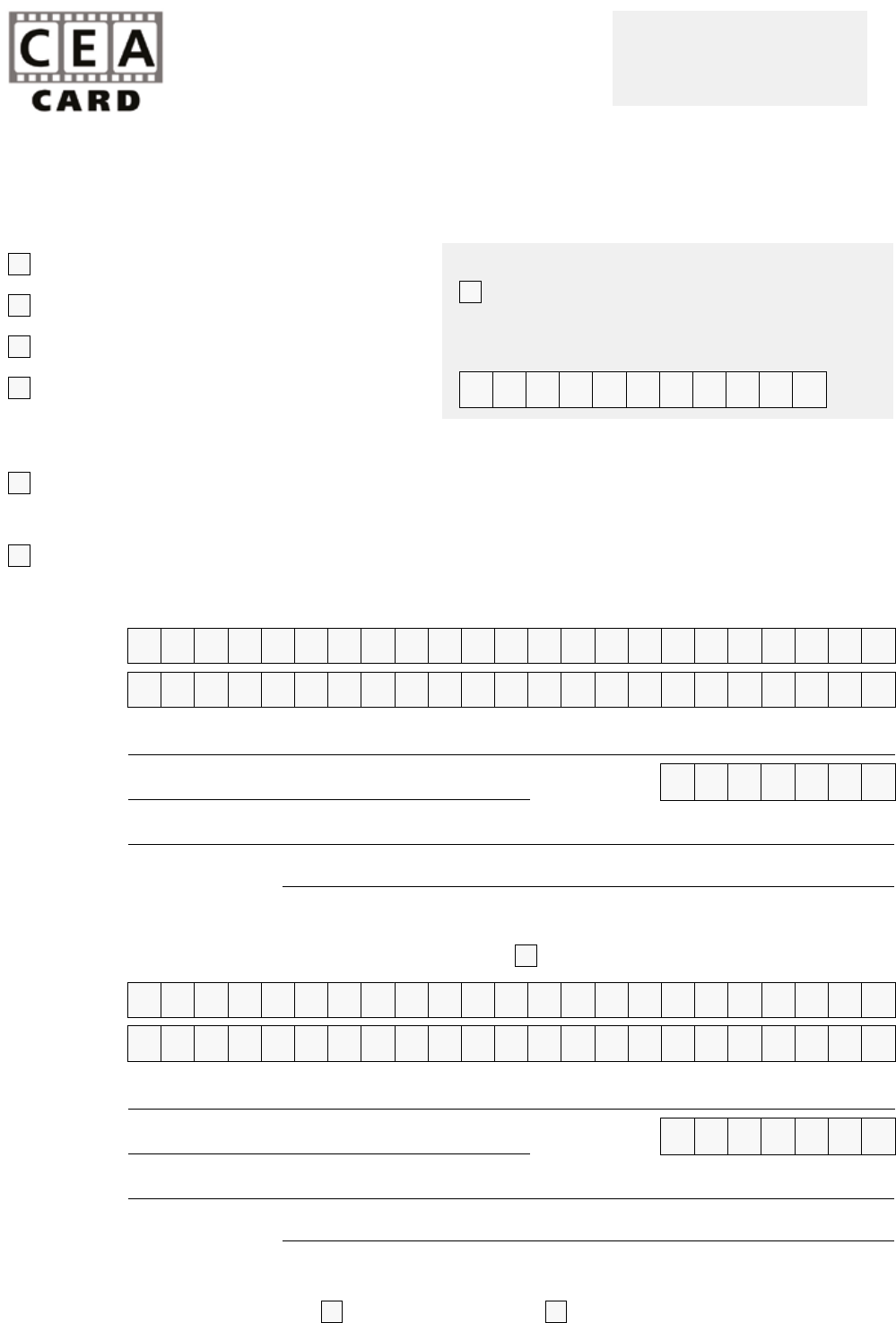
First application for a CEA Card
Replacement of a lost CEA Card
Replacement of a stolen CEA Card
Renewal of an expired CEA Card
Forename:
Surname:
Address:
Town/City: Postcode:
Email:
Daytime contact Number:
Who should we contact regarding this application and about card renewal in the future?
The person requiring assistance Parent, carer etc
Application Form
Apply online at
www.ceacard.co.uk to save
time & postage
The CEA Card Scheme is open to persons aged 8 years and above.
All applications must include proof of eligibility and payment of £6.
For Picturehouse Cinema Carers Card holders only
Picturehouse Carers Card Number Only
Please tell us who is completing this application:
I am completing on behalf of the person who requires assistance to visit the cinema
(e.g. I am the parent, carer, support worker or helper)
I am the person requiring assistance to visit the cinema.
Section 1 – Your Details (the person completing the form)
Please complete using BLOCK CAPITALS. Please tick one of the following:
Forename:
Surname:
Address:
Town/City: Postcode:
Email:
Daytime contact Number:
Replacement for a Picturehouse
Cinema Carers Card
Section 2 – Card Holder Details (the person requiring assistance). If these details
are the same as in section 1, please tick here
CEA Card Application Form

I confirm that the person requiring assistance is 8 years or older.
I have read and agree to the CEA Card terms and conditions.
These can be viewed on our website at www.ceacard.co.uk
Card Holder Photo
The photo should be passport sized, in colour and be an
accurate and recent likeness of the person requiring the
assistance. Please write the name on the reverse in case
it becomes separated from the application.
Proof of Eligibility
Please enclose proof of eligibility for the person requiring the assistance. This should be
dated within the last 12 months. If you are applying to replace a Picturehouse Carers
Card, you do not need to send proof of eligibility again. We accept the following:
Please
attach the
photo here
●
Disability Living Allowance
●
Armed Forces Independence Payment
●
Attendance Allowance
●
Personal Independence Payment
●
Severely Sight Impaired (formerly
Registered Blind) or Sight Impaired
(formerly Partially Sighted).
Photocopies are accepted, although we reserve the right to request original
documents on occasion. If you are sending original documents and wish them to
be returned, please enclose a SAE (Stamped Addressed Envelope), otherwise
they will be securely shredded.
I have enclosed a SAE. Please return my original documents.
Payment of Processing Fee
I have included a cheque or postal order for £6 made payable to CEA CARD.
Please do not send cash.
Confirmation
You must confirm you agree with these statements for us to process this application.
Please post your application to:
CEA Card, PO Box 199, Deeside CH5 9BW.
For more information visit www.ceacard.co.uk, email us at [email protected] or
contact us on 01244 526 016. Textphone 18001 01244 526016.
I would like to be contacted via email with additional information and offers
from cinemas.
I need a Braille label on my card.
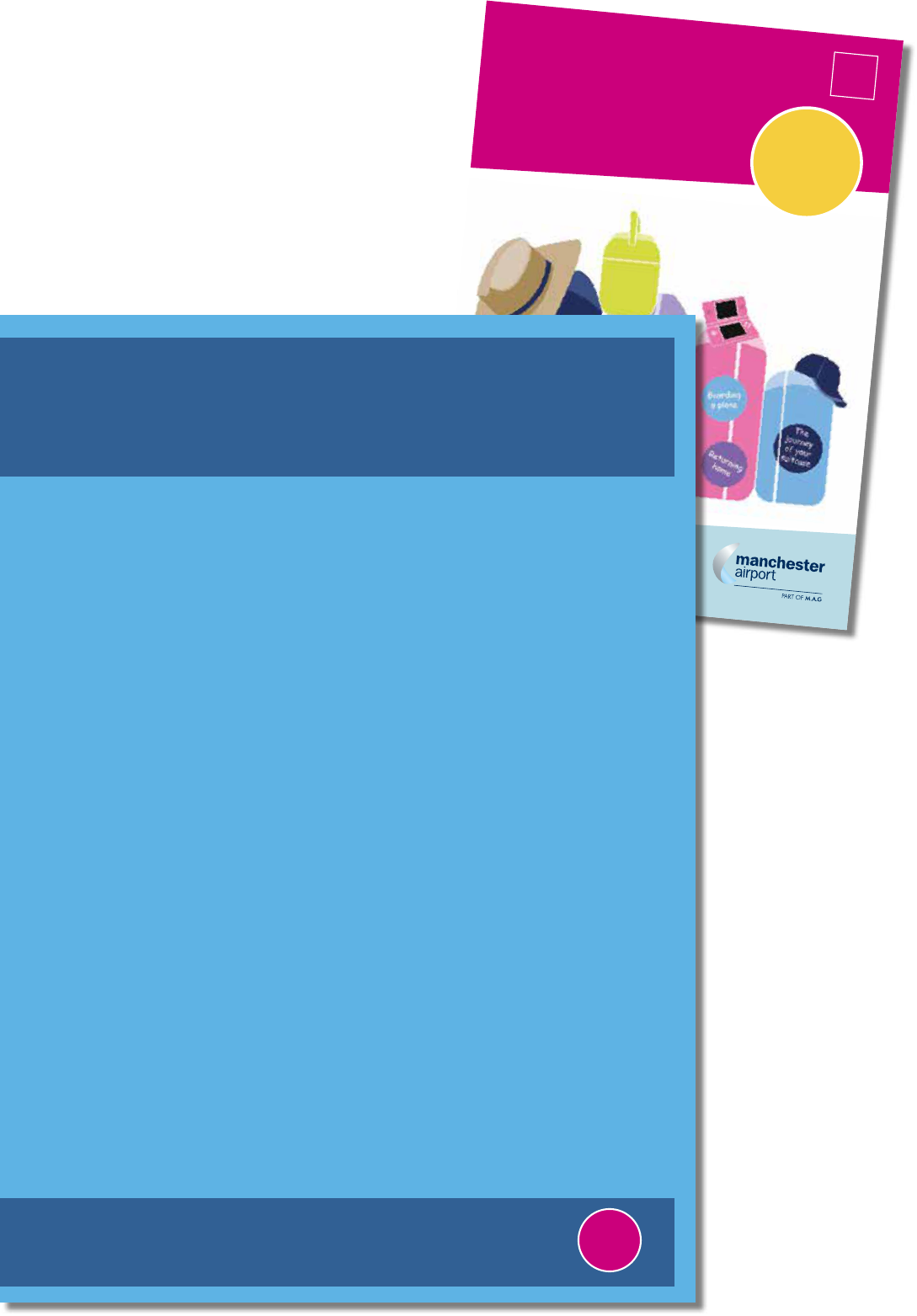
Airport
T1
Awareness
Travel advice for parents and carers of children
on the Autistic Spectrum
FREE
manchesterairport.co.uk
INTRODUCTION
Welcome to Manchester Airport’s ‘Airport Awareness’ book to help parents and carers of
children on the Autistic Spectrum understand what will happen on their journey through
Manchester Airport.
In each section we have included travelling tips for parents and carers to
help make your journey easier. Follow the key (shown left) on each page to
see our top tips on pages 23 and 24.
1
We realise here at Manchester Airport how stressful travelling through an airport can be for
children on the Autistic Spectrum, especially when it’s a break in their routine and they are
unsure of what to expect.
This book will take you on the journey through Manchester Airport, using photographs
to explain the process you will take. It has been divided into the various stages of your
journey through the airport, describing what you will see and hear, from arriving at the
airport, going through security and through to returning back home.
In each section there is a tick box for you to interact and engage with your child in the
sights and sounds along your journey through the airport. We have now launched an
accompanying video we can be viewed at www.manchesterairport.co.uk, where an online
version of this booklet can also be downloaded. There is space at the back of this book for
your child to jot down any worries they may have and also a fun zone to fill time when you
may be waiting around.
We are committed to making every passenger’s journey as easy and stress free as
possible. We have many different passengers who pass through Manchester Airport, all
with different needs, and this book is just one of the ways we can help with their experience
of the airport.
We understand the difficulties you may face when coming through the airport with a child
on the Autistic Spectrum and we will do as much as possible to help you travel through
quickly and easily.
To make it as stress free as possible for you and your child, you can now request a free
wristband for your child to wear which entitles the child wearing it, and all accompanying
members of the party, to use the fast-track security lanes in each terminal. Simply call
08714 777 747 or email customer[email protected] to request one. We also
welcome any feedback you may have about this book or suggestions on how we can make
your journey easier through Manchester Airport to this address.
Tricia Williams, Customer Services Director at Manchester Airport
TIP
1
Airport
Awareness

Holiday social stories
It is important to remember that social stories should be unique to your child, these are examples
of social stories, you might like to copy some of the pictures or use some of the sentences if they are
appropriate. Remember many of the social stories are American and so you will need to consider
wording, for instance, ‘holiday’ rather than ‘vacation ‘.
Sample ‘back to school’
social stories
Back to School
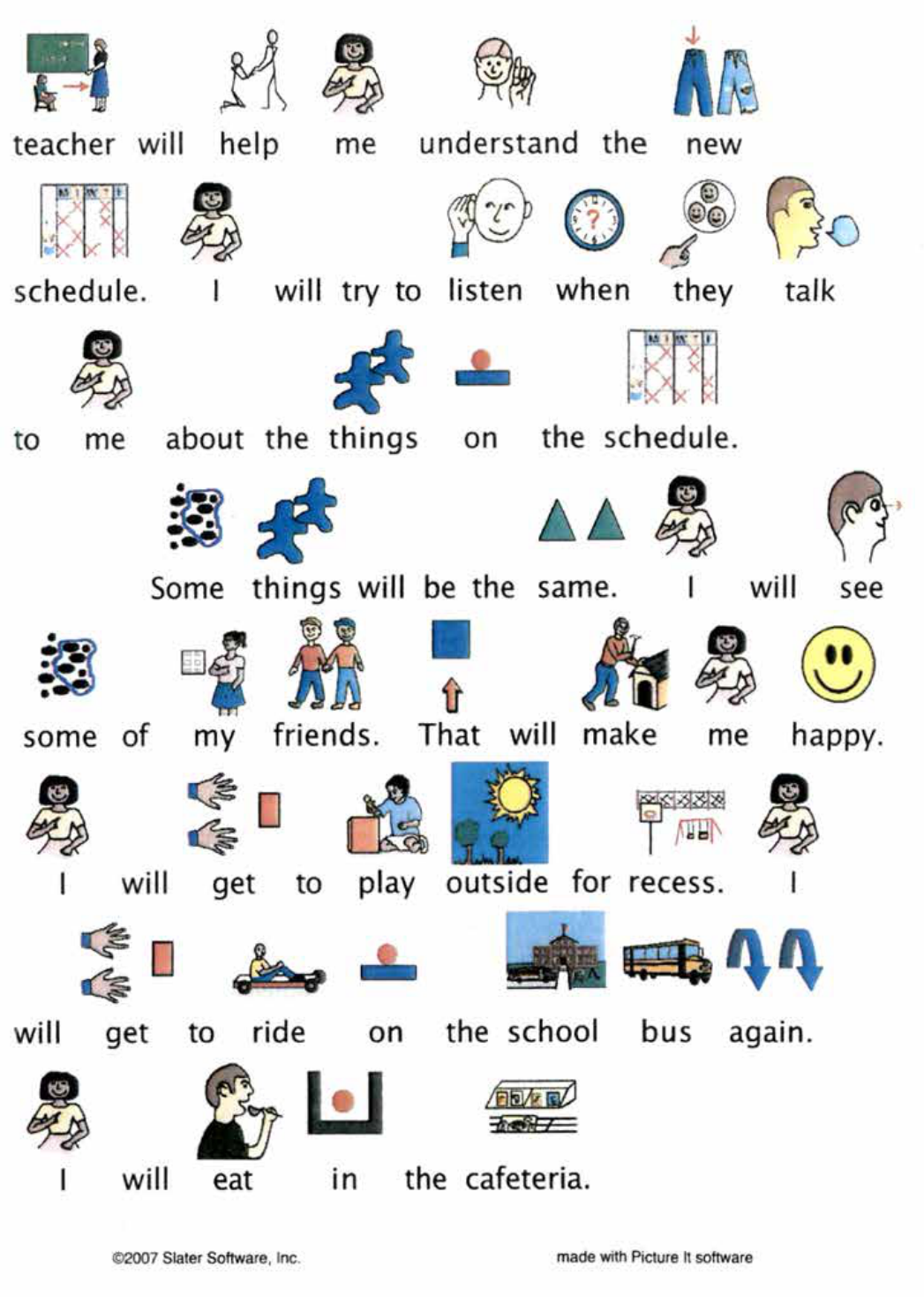
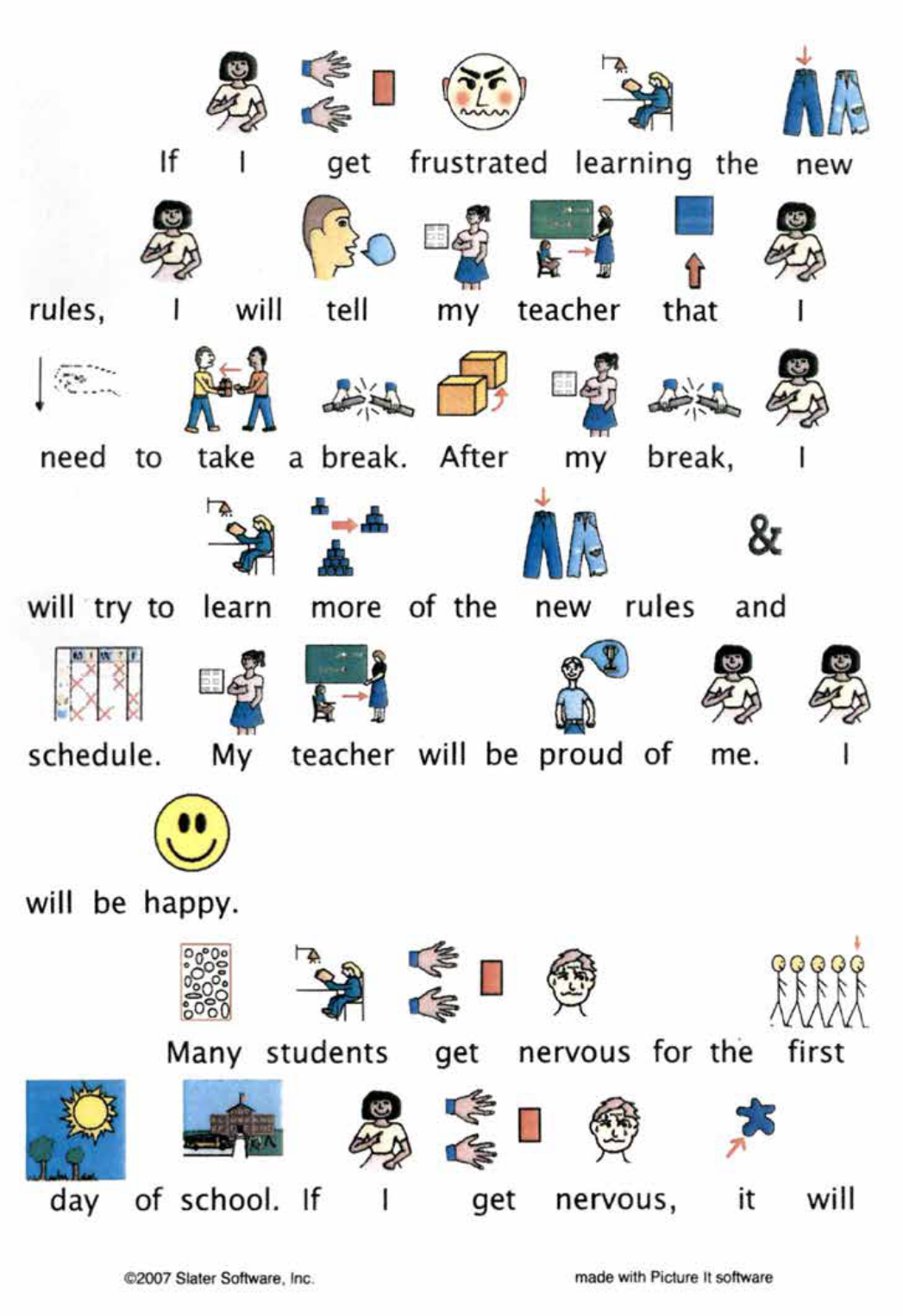
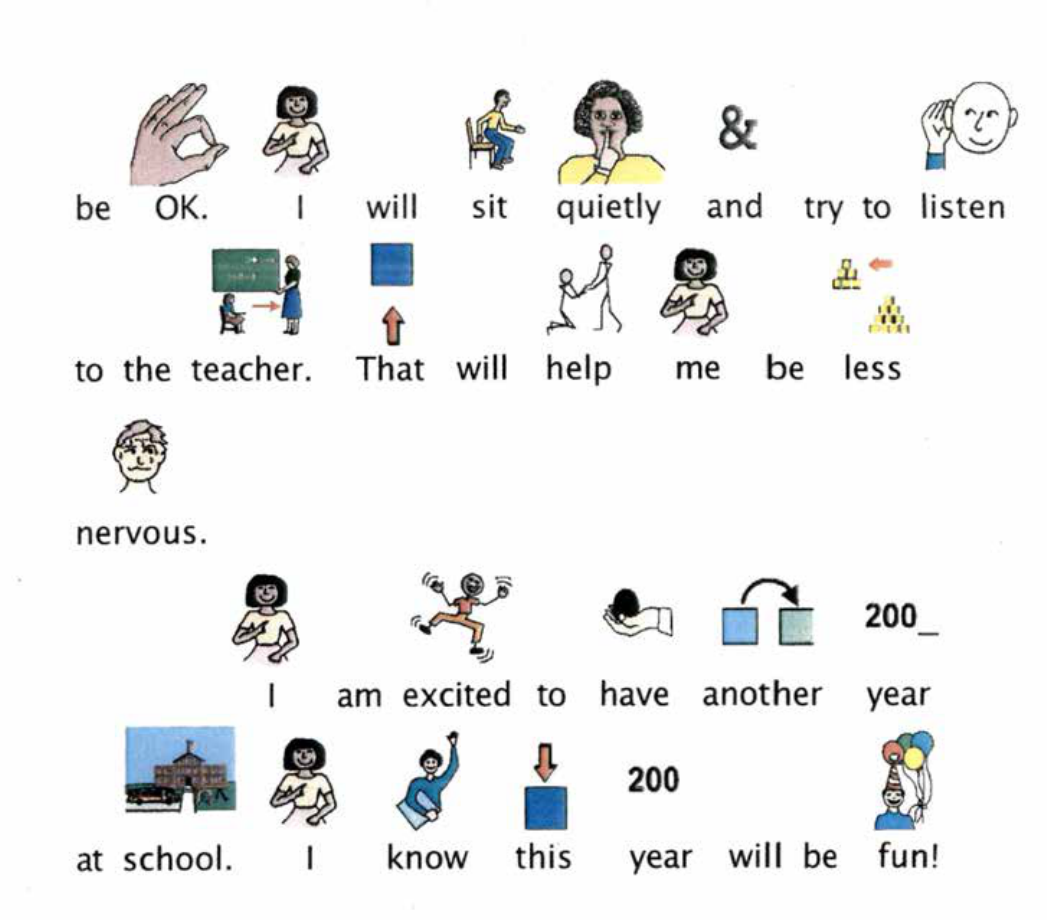

A New Classroom
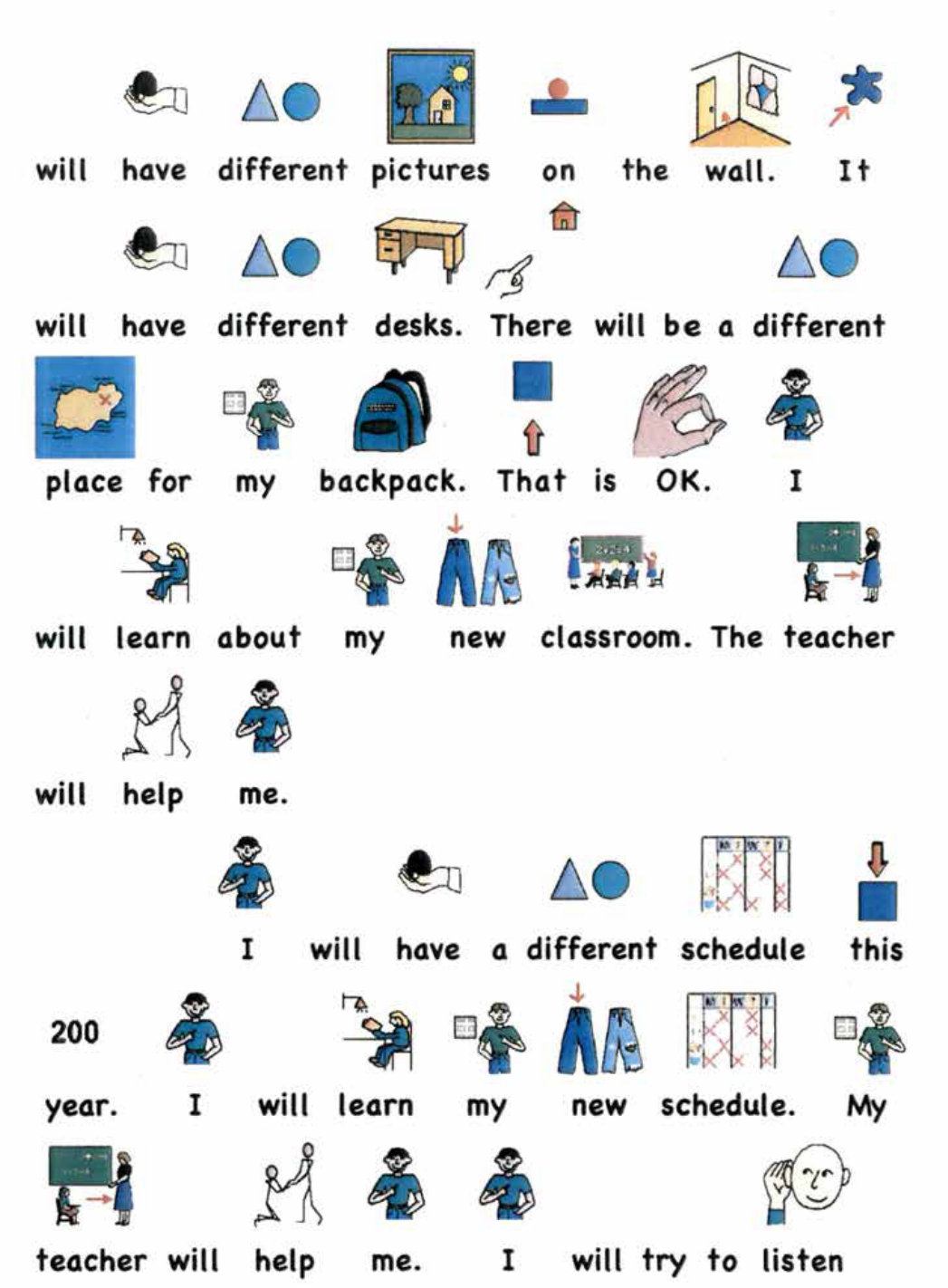

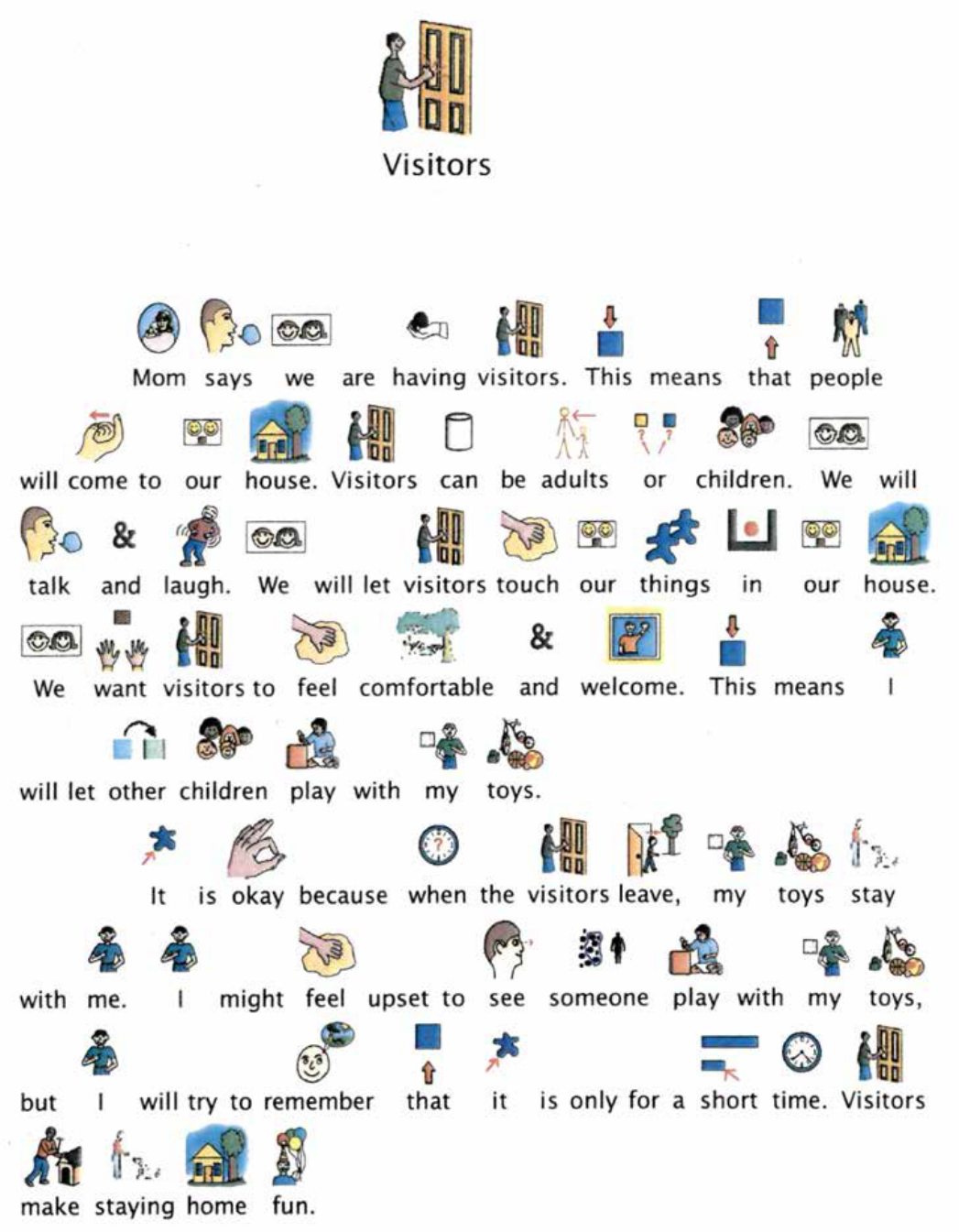
Sample ‘visitors’
social stories
Visitors
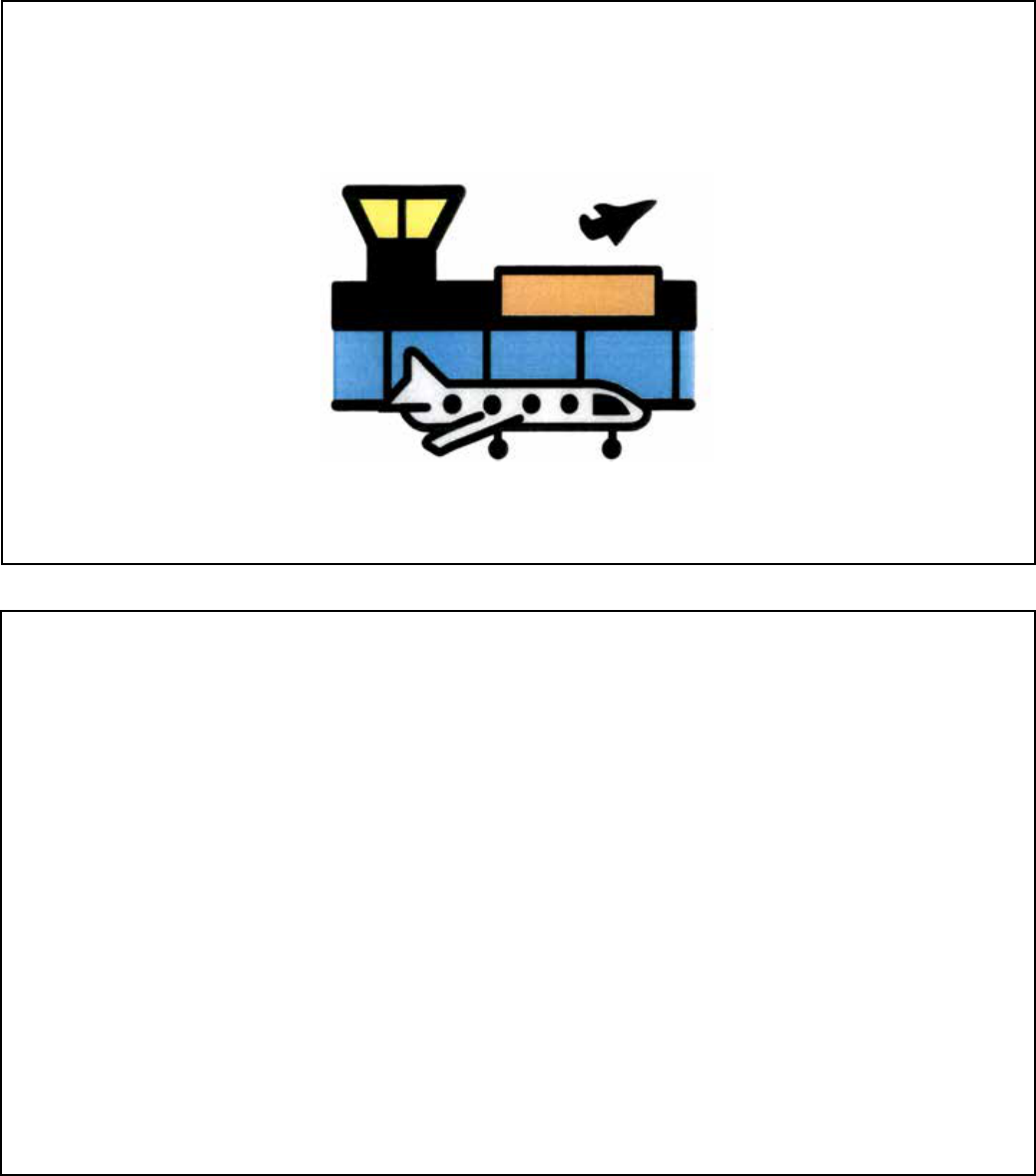
Sample ‘airport’ social
stories
The Airport
Sometimes people go on vacation. Some people go on vacation in a car.
Some people go on vacation in an airplane.

I usually will go with my parents to the airport but maybe
I will go with _ _ _
When we get to the airport, I have to get my suitcase. I have to wait for
mommy or daddy to show me where I might have to go.
___

When I walk in the airport, the noise level might be high. There might be a
lot of people so I should stay close to my mom or dad.
I might have to wait in line when we check in our luggage. Then we get
our plane tickets so we can a board the plane.

When I get my ticket, I might have to wait until it is my turn to aboard
the plane.
I may have to wait a long time so I can play a game or look at a book.

When the person calls my seat number then I may aboard the plane.
I have to look for my seat number. I might have some carry on luggage
that has to go in the overhead storaae.

I have to walk to my seat with my mom or dad.
When I find my seat, I have to sit down and put on my seat belt. A person
might help me find my seat and mcike sure my seat belt is fasten.

I may have to wait for the captain to tell me that we are able to take o. I
need to relax. I can take some breaths or I isten to some music. I can also
watch a movie or play a game.
When I am in the airplane, I might hear the engine start. It might get
louder. I might hear the wheels go up.

____
When the plane gets close to its destination, the wheels wi 11 come down.
As the plane lands, the plane hits the ground which the ride will be bumpy
and loud.
As the airplane is coming to a stop, it will pull up to a terminal so people
can exit the plane. Then a person will come on the intercom and say,
“Welcome to _ _ . Hope you enjoyed your f I ight”.
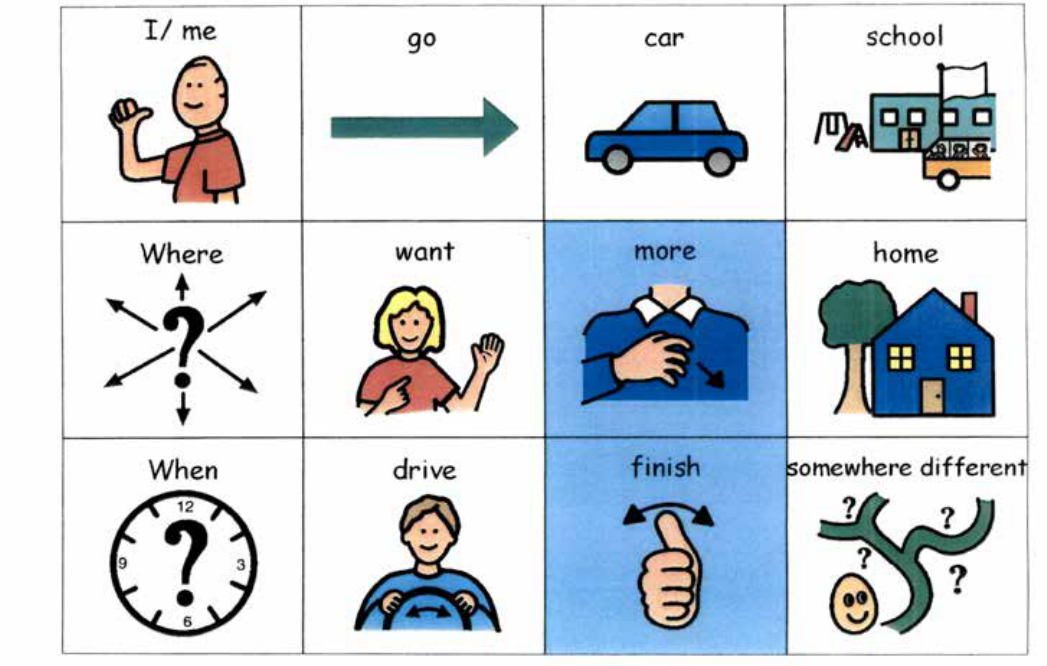
‘Going places’ visuals
Going places
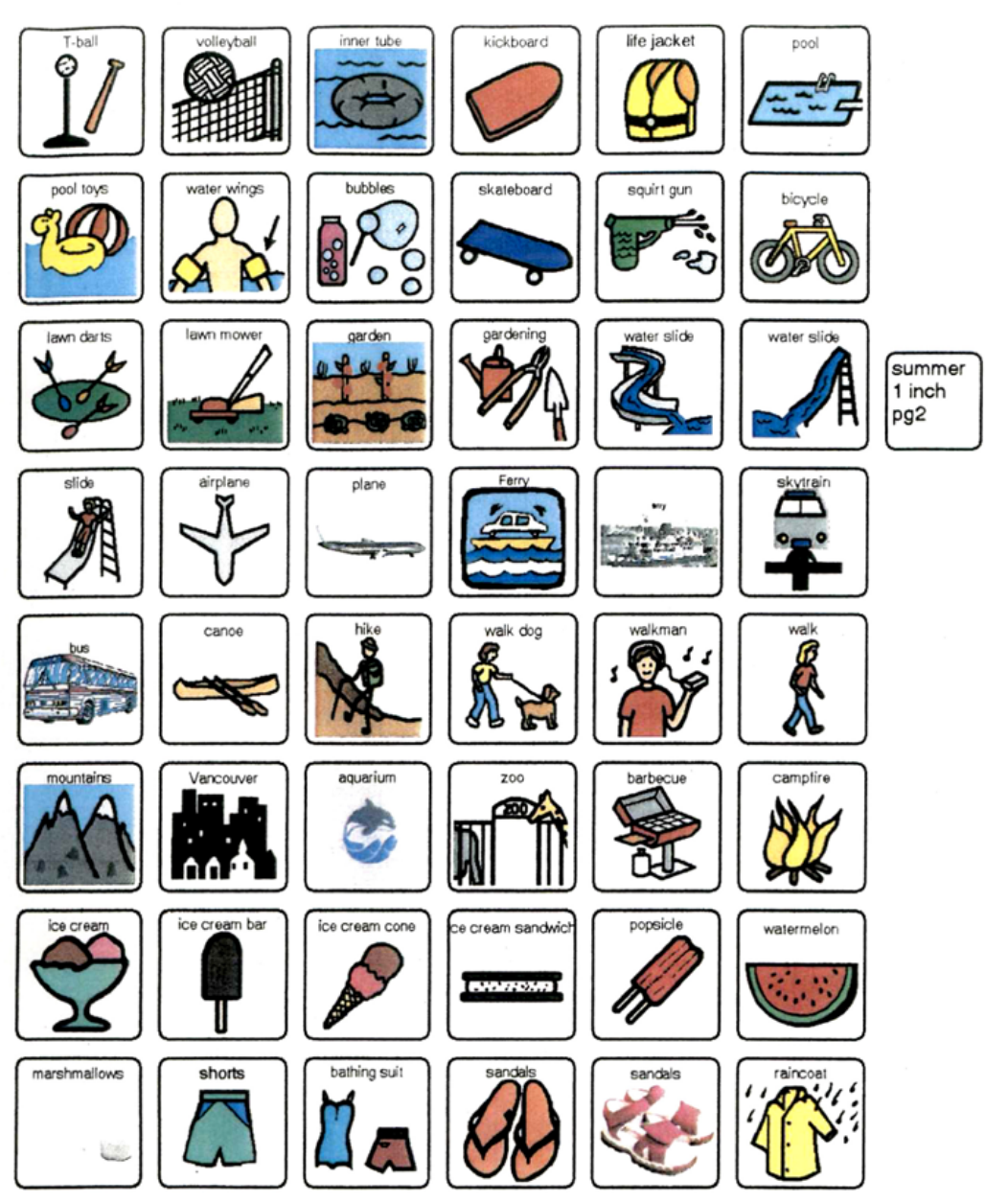
Useful summer vocabulary
symbols
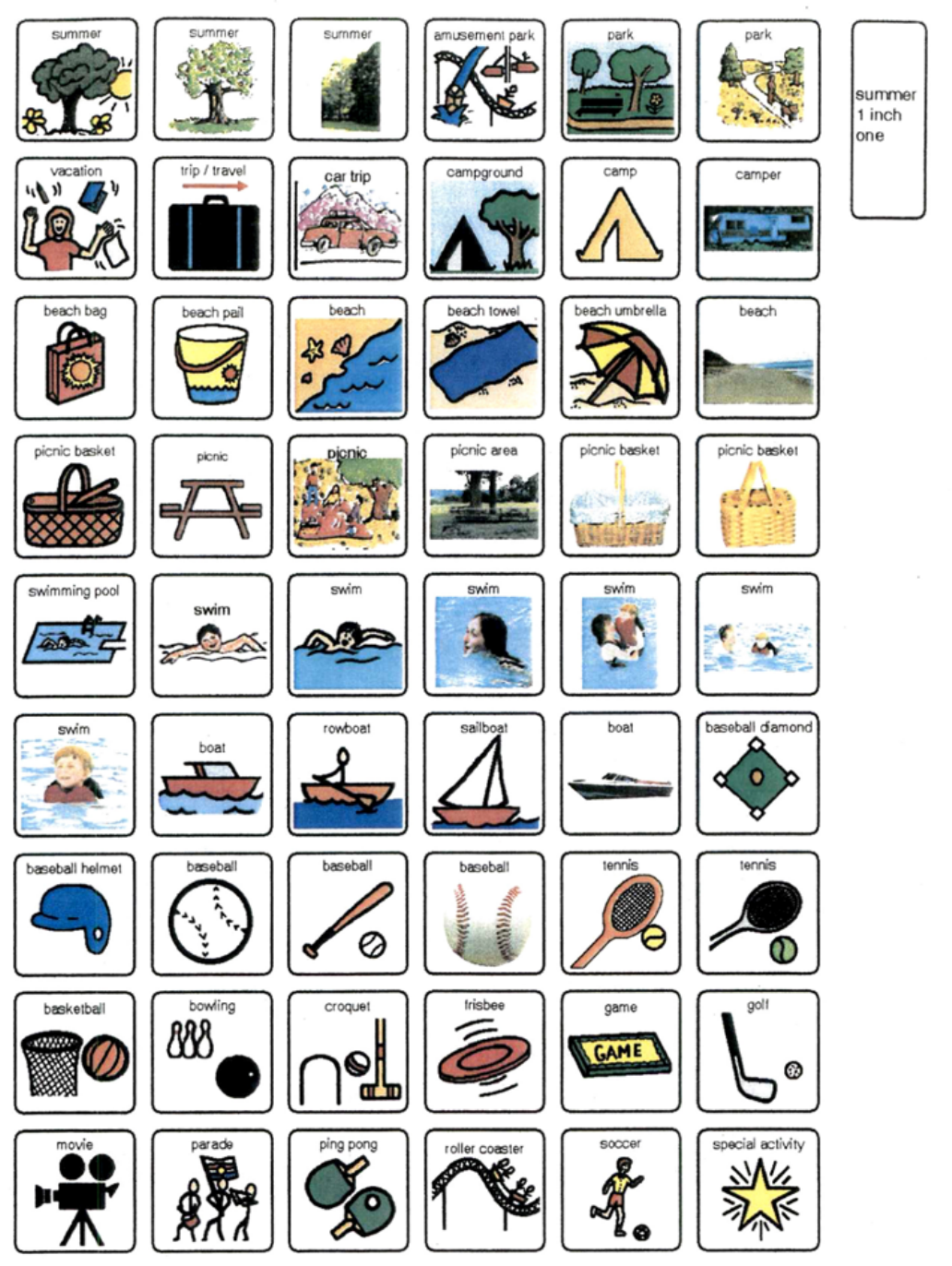
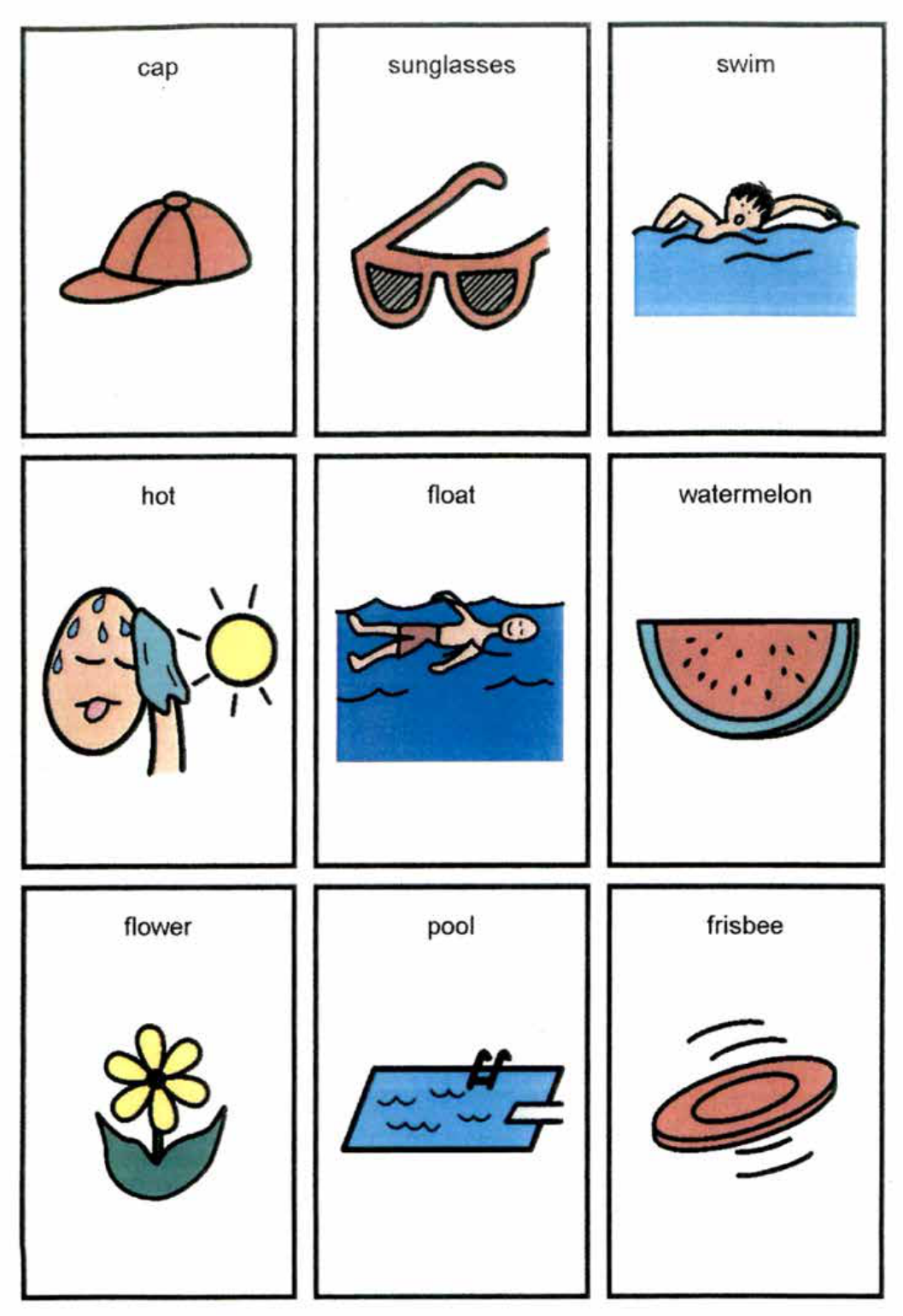
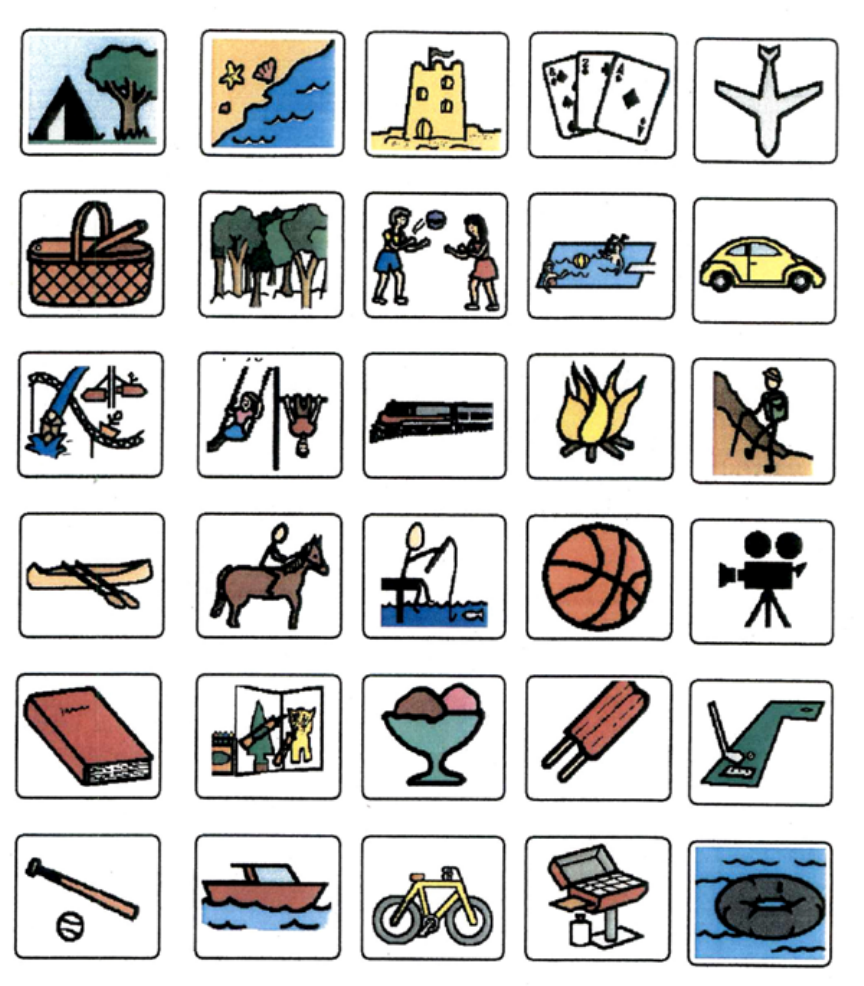
My Summer Vacation
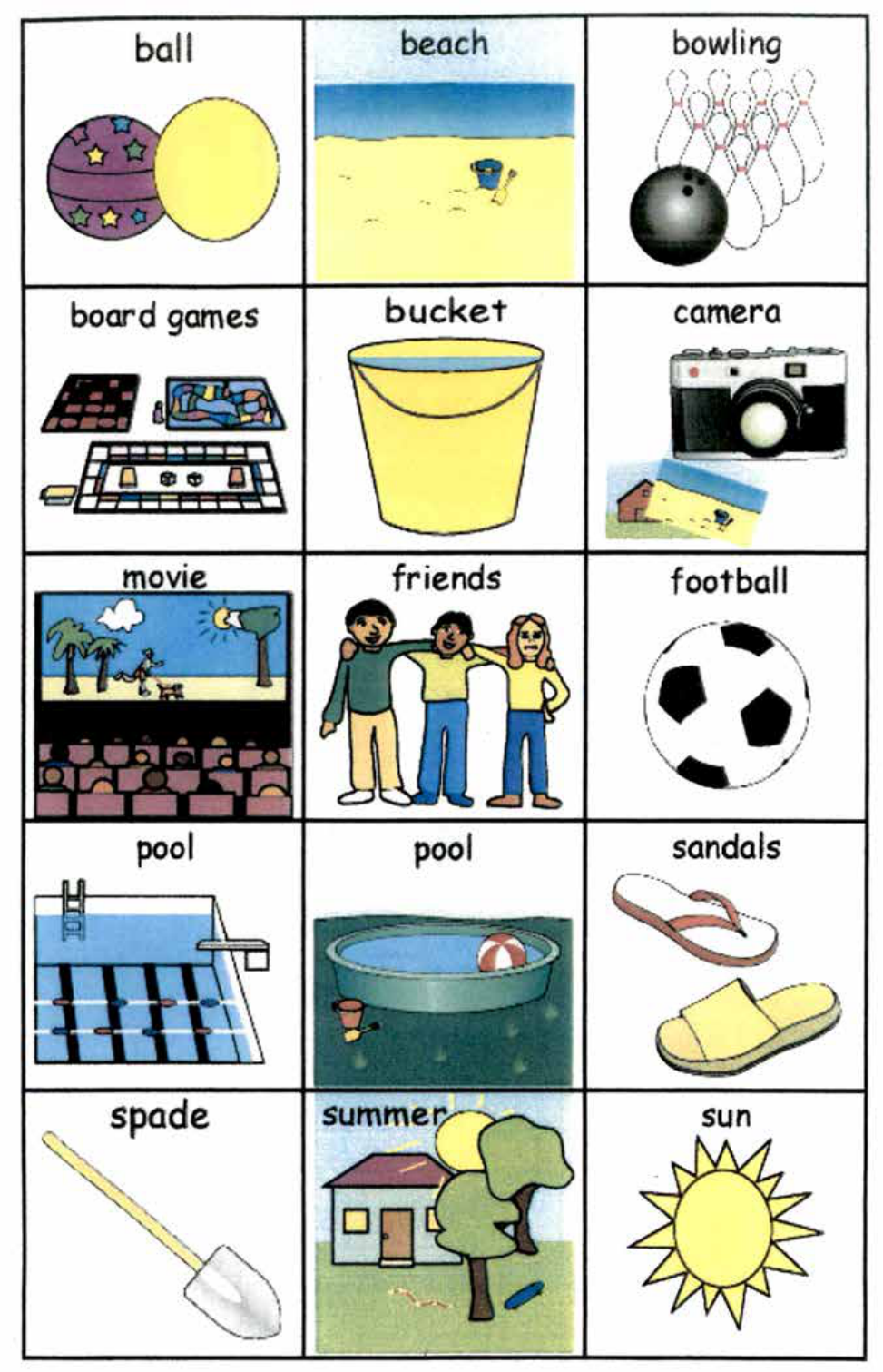

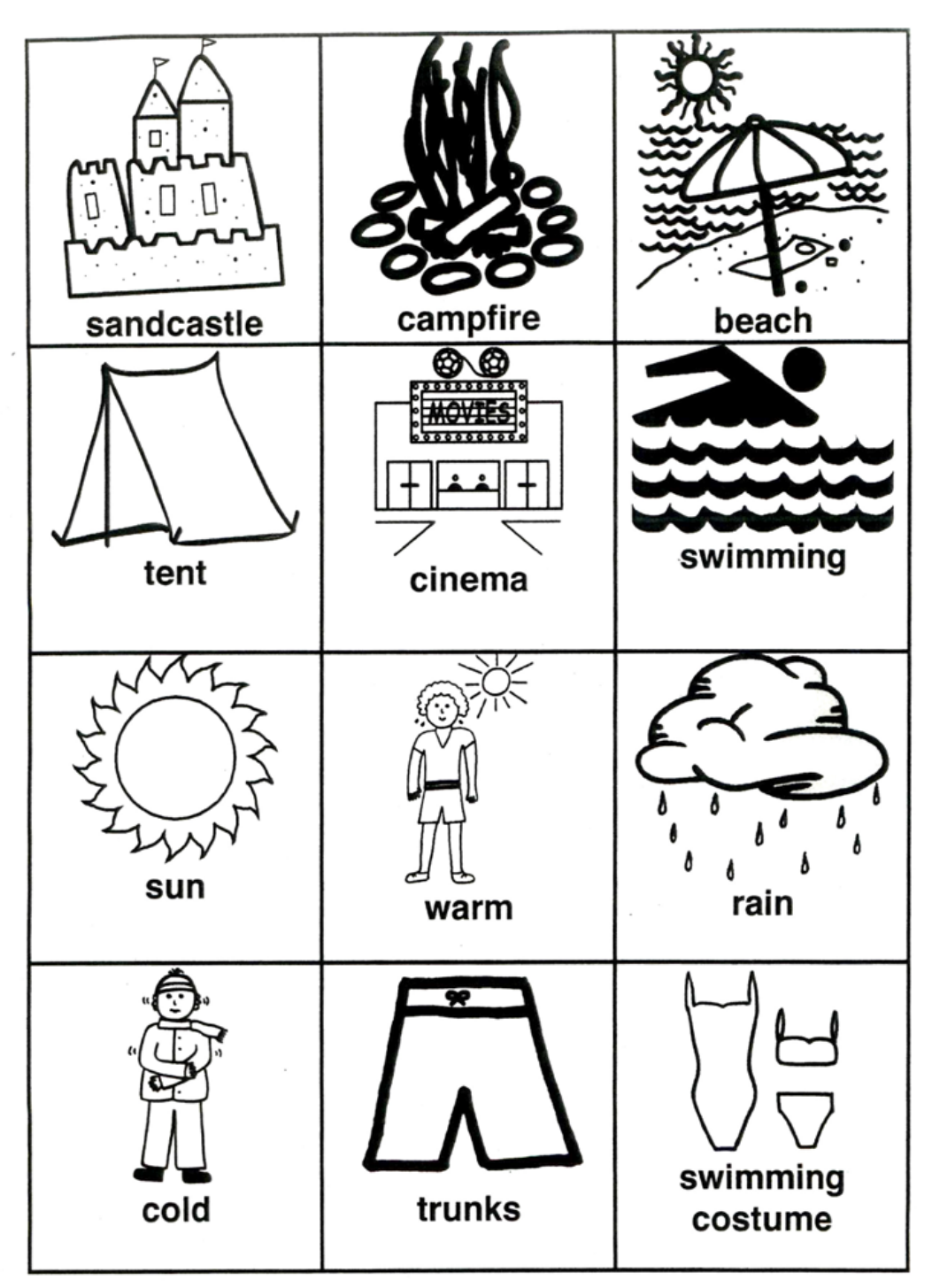
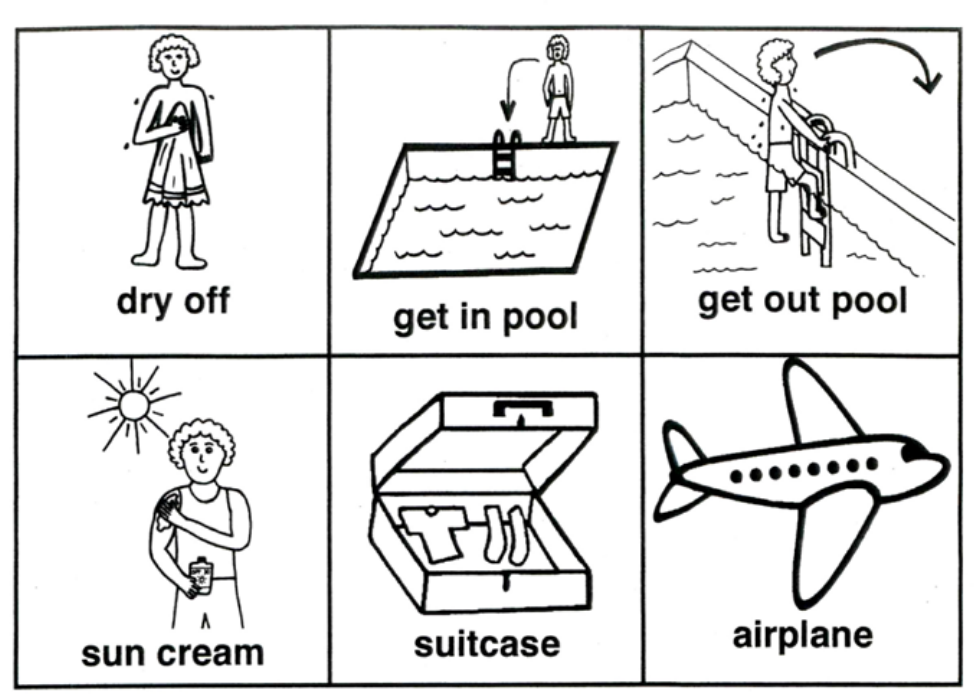

Skill Sheets
by Sandbox Learning
Ideas for Making Short and Long Trips Less Stressful
Ideas for Making Short and Long Trips Less Stressful
Family vacations create lifelong memories and part of the experience is traveling to the
location. For some children this can be exciting while for others it can be stressful. This article
includes ideas for reducing stress before and during travel.
1. Prepare Children – Reduce anxiety by telling children what to expect. Prepare children by reading
books, writing stories, and discussing the upcoming trip. If the experience is new be sure to explain it
to the child. For example, if a child is flying for the first time, explain the security process of taking off
their shoes, putting their possessions in a machine, and waiting to go through screening. Clearly
outline the steps to prepare children. Additionally, let children know how long the trip is going to be
or set a timer so children know when they will arrive. Some children may benefit from a picture or
word schedule of the events on the trip. The schedule allows children to understand visually what is
happening next. Be sure to update children on traffic jams or flight delays that change their travel time.
2. Involve Children – Let children help pack their bag. This can prepare children for changes in the
weather, trip related events, and items they will have access to on the trip. Packing is a great
opportunity to teach organization and planning skills. Discuss different clothes that are appropriate for
events. For example, discuss how they are packing a nice outfit for Thanksgiving dinner, but warm
play clothes for playing outside with their cousins after the meal. Give children choices in items. For
example, let children select one of three sweaters to wear for a nice dinner. Letting children make
choices involves children and lets them take an active role in the experience. During the trip have
maps and pictures of people or places they are going to visit to give them something to look at and
discuss related to the trip.
3. Keep Comfort in Mind – Whether driving or flying, trips are more
stressful and unpleasant when children are uncomfortable. Be sure
there is plenty of personal space in the car. Stop regularly so children
can stretch and use the restroom. Although planes are limited by space,
children often like to look out the window. An inside seat on a plane
also limits contact from other people walking up and down the aisle.
Bring lollipops or gum to help children’s ears adjust with the pressure
changes.
From Going Places
4. Bring Activities – Have children select a few stories or games for the trip. Keep portability in mind
as well as the length of time the activity holds the child’s interest. Often children like videos and video
games. These are engaging for children, but old-fashioned car games such as I Spy or Twenty
Questions are ways to entertain and teach while communicating with children.
5. Use Positive Reinforcement – Regularly praise children for sitting, listening, and being a good
traveler. Be clear about what they did well such as, ‘Great job waiting for your turn in security and
listening to the security officer.’ Be sure to consistently reinforce behavior throughout a long drive or
flight to let children know you see they are doing a good job.
To receive a free customizable children’s book on waiting, please visit our website:
www.sandbox-learning.com
Co
py
ri
g
ht © 2008 b
y
Sandbox Learnin
g
. All Ri
g
hts Reserved.
Skill Sheets by Sandbox Learning

Six Tips for Vacations and Weekend Trips
Family vacations create memories, teach children about new places, and provide an
often much needed break. Unfortunately, some children have a difficult time with new
situations, people, and schedules. This article includes ideas for making vacations and weekend
trips less stressful and more enjoyable before, during, and after the trip.
1. Prepare Kids - Unfamiliar places and situations can be very stressful for some children. Prepare
children for a trip by showing them websites, brochures, or guidebooks. Pictures of lodging,
activities, people going on the trip, and transportation are helpful for setting expectations. If you are
flying, discuss the security process and etiquette for sitting on the plane (using an inside voice,
keeping on a seatbelt, having feet off the seat in front of them).
2. Involve Kids in Planning – If you are debating where to go, involve children in the decision.
Research different trips and discuss the strengths and weaknesses of each place. Consider
children’s interests in the decision. Because you loved the beach as a child does not mean your child
who does not swim, sunburns easily, and finds the feel of sand upsetting will like the beach. Before
a trip, let children help pack their suitcases so they know what they will have with them. Use this as
an opportunity to discuss the weather and appropriate clothes for activities. Pack and have readily
available a small bag of toys and books for car rides, unexpected waiting periods, and downtimes.
3. Create a Sense of Familiarity - Consider children’s routines and familiar possessions when
planning trips. Sleep schedules may be difficult to follow, but keep wake up and bedtime as close
to the child’s usual schedule as possible. Familiar objects also help children with consistency. If a
child reads a favorite story before bed, carries personal items in a backpack, or uses a stress ball, be
sure to pack these items.
4. Keep Children Aware of the Schedule – Many children benefit from very structured schedules
and the lack of a familiar schedule on a vacation can be upsetting. If children use written or picture
schedules, create one for the trip. Some children just need a verbal reminder of what to expect next
or when to change activities. Many times consistently keeping children notified of the schedule and
schedule changes helps them relax and transition through the day.
5. Remember Downtime is Important – Families often over plan vacations. Spending time with
friends and family, going from one location to another, or doing a number of things at one place can
exhaust children. Plan rest periods so children can read, play a game, or nap.
6. Create Memories – Trips are fun and exciting, but children often forget some of it when they
return home. Buy a travel diary before the trip. Every evening discuss the day’s events. Have
children write in the journal. They can add pictures, tickets, and brochures from the day. Read the
book during the year to remember the experience, encourage communication, and plan future trips.
To receive a free customized children’s book on waiting, please visit our website:
www.sandbox-learning.com
Co
py
ri
g
ht
©
2007 b
y
Sandbox Learnin
g
. All Ri
g
hts Reserved.
Skill Sheets by Sandbox Learning
Six Tips for Vacations and Weekend Trips

Activities for Summer Break
Activities for Summer Break
Summer is a much needed break for many children and families. Make the most of
summer by helping children have fun while learning new things. The ideas below are
for children of all ages and include suggestions for both the home and the community.
1. Enjoy the Weather – Many communities have swimming lessons, group sports, or one-day neighborhood
events. Encourage children to participate in these activities so they make new friends, learn new sports, and
stay healthy. If children are ambivalent about trying something new, let them join with a friend. Children
may be more interested in an activity if one of their friends is on their team or in their swimming group.
Doing outdoor activities is a great way to spend quality time with your children and show the importance of
physical fitness. Make evening walks or bike rides part of your routine. Besides doing physical activities
outdoors, learn to simply enjoy the nice weather by having picnics or sitting outside to read or have a snack.
2. Explore Creative Opportunities – There are many free websites with printable games, coloring pages,
and ideas for simple art activities. These easy and free resources are fun for children. To locate activities,
search the internet using keywords like ‘children’s art activities’ or ‘children and art’. Additionally, many
art supply stores, arts centers, children’s museums, and home improvement stores offer free or low-cost one
day clinics. The classes usually appeal to children of a wide age range and are offered on a regular basis.
Don’t forget to check activities in your community center. Many community centers offer singing, acting, or
music classes to help children of all ages explore their creative side.
3. Invite Friends to Play – Plan play dates for children. Besides having fun
while playing, children develop important social skills by spending time
together. When planning a play date, have a variety of fun games and activities
handy to encourage children to interact instead of watching television. Rain or
very hot weather can prevent children from playing outside so be sure to have
board games, cards, and other indoor activities handy in case they can not go
outside. Simple games are not only fun for children, but they teach important
skills such as turn taking, sharing, problem solving, and conflict resolution.
From Playing Together
4. Complete Projects Together – Projects such as planting a garden, planning a summer party, or
researching ideas for the family vacation are exciting summer activities. Include children in your projects to
teach them time management, responsibility, and life skills. If you are planting a garden, children can learn
about plants, water them regularly, and pick fruits and vegetables. If you are planning a party, kids can help
make invitations, plan the menu, or prepare the food. If you are planning a family vacation, show children
guide books and maps and let them help plan different events for the vacation. Children like to spend time
with adults and work with them on projects. These activities will engage children and teach them valuable
skills while giving you a little extra help.
5. Read More – Encourage reading for enjoyment by including reading activities in your routine. Local
libraries often have story time for preschoolers and a variety of other learning activities for elementary aged
children. If your local library does not have these programs, have fun at the library by browsing and
checking out books with your children. Also, check your local book stores for children’s program. They
frequently have similar story times and fun programs.
To receive a free customizable children’s book on waiting, visit our website:
www.sandbox-learning.com
Co
py
ri
g
ht © 2006 b
y
Sandbox Learnin
g
. All Ri
g
hts Reserved.
Skill Sheets by Sandbox Learning

Getting Ready for Summer Break
Getting Ready for Summer Break
1. Prepare Kids – Prepare children for the summer break while they are still in school.
Classrooms often have a countdown to summer, but including one in the home also is
helpful. Discuss summer break with children including when they will return to school and what they
will do over the break. Read books about vacation, summer, and school breaks.
2. Make Cards – If children are concerned about not seeing their friends
and teacher, have them create cards for everyone. The cards can have
memories from the school year or a simple message, “Have a nice summer.
See you in August.” Cards are a great way for children to share their
feelings and learn about giving.
3. Don’t Forget School – Arrange summer play dates with classmates
before school ends so children know they will see their friends soon. Use
the class picture as a way to discuss and remember classmates, or make a
book about the past year, “Bobby’s Year in First Grade.”
From the book, School Breaks
4. Maintain Structure – The school day provides a significant amount of structure for children. A
transition from a full day of planned activities to one with little structure can be very difficult for
children. Have a routine so children have consistency in their lives. Set times for waking up, going to
bed, eating, and other activities so children know what to expect during the day. If children have a
routine with different activities on different days of the week such as swimming lessons Monday,
Wednesday, and Friday and library time on Tuesdays, make a calendar showing these activities with
words or pictures so children see the day’s activities. Some children may benefit from a very
structured schedule. If children use a picture schedule at school, ask their teacher how to implement it
at home. Besides including structured activities, remember a schedule can include periods of choice
and free play while still providing support and structure.
5. Keep Activities Handy – Keep materials for art activities (paper, paints, buttons, glue, magazines)
handy. Art activities develop fine motor skills and encourage creativity. Cooking lunch or snacks is a
fun activity for children and it encourages reading, basic math (fractions, counting), and turn taking.
6. Start Summer-Long Responsibilities – Give children activities for the summer. Gardening
activities such as a small plot in the family garden or an indoor herb garden are a great opportunity for
children to watch plants grow, care for them, and see the fruits of their labor. If children are not
interested in gardening, give them responsibilities with the family pet (brushing, feeding, walking) or
another household activity. These activities can be expanded upon by reading about the topic or
attending events involving the topic such as a local flower show or dog show.
7. Ask the Teacher – If you have concerns about a child’s transition from school to summer, ask their
teacher for suggestions. The teacher may have specific ideas for your child’s needs or they may know
about community activities your child would enjoy. They also can provide ways to help your son or
daughter prepare for the next school year.
To receive a free customizable children’s book on waiting, visit our website:
www.sandbox-learning.com
Co
py
ri
g
ht © 2006 b
y
Sandbox Learnin
g
. All Ri
g
hts Reserved.
Skill Sheets by Sandbox Learning

End of Summer Activities to Prepare for the School Year
End of Summer Activities to Prepare for the School Year
The start of the school year is an exciting time but the transition back to school can
be stressful for many children. Help children prepare for the new school year with these
helpful strategies.
1. Review Skills and Goals – Review school reports and goals and document progress towards goals.
If teachers and therapists provided activities or ideas to address skills, take the time to focus on these
prior to school starting. Even small reminders about skills can help prepare children for addressing
these in the classroom.
2. Take Advantage of Natural Learning Opportunities - Use natural opportunities to address a wide
range of skills such as asking a child to help count silverware while setting the table (counting skills)
or asking them to read directions while cooking (reading skills). By keeping a child’s goals top of
mind, natural learning opportunities can be easily identified.
3. Use a Calendar for Visual Reminders – Many children benefit from visuals. Mark important
events leading up to the start of school on the calendar. Examples of activities to put on the calendar
are the first day of school, shopping for school clothes, and buying school materials. Discuss how
many days are left until each event and have children participate in planning by helping write shopping
lists and decide where to shop.
4. Return to a Schedule – Summer breaks often are not very
structured. Start getting back into a routine so children are more
prepared for the school year schedule. Sleeping, eating, brushing
teeth, bathing, and bedtime rituals are examples of activities
typically scheduled at set times in a child’s routine. Work on a
consistent schedule to help transition back to school.
5. Use Art and Literature - Have children draw, make collages, or
paint things they remember about the previous school year. Have
them write about or discuss what things they like about school and
what they are looking forward to in the new school year. Use these
memories as visuals to discuss returning to school.
From: Getting Ready for Bed
6. Play with Friends from School – Some children regularly see classmates over the summer while
others only see school friends during the school year. Schedule play dates or host a classroom party to
help children become re-acquainted with each other.
7. Enjoy the Rest of the Break – Although planning for the school year is important, make the most
of the last few days of summer. Create lasting memories by going on picnics, attending community
events, and taking advantage of extra family time. Take pictures to remind children of summer
experiences and create a ‘Summer Memory’ book to encourage communication and language. This is a
perfect item for show and tell at the start of the school year.
To receive a free customized children’s book on waiting, visit our website:
www.sandbox-learning.com
Co
py
ri
g
ht
©
2008 b
y
Sandbox Learnin
g
. All
R
i
g
hts Reserved.
Skill Sheets by Sandbox Learning
